Machine Vision Frameworks
GigE Vision 2.1
Bottlenose cameras are compliant with the GigE Vision 2.1 standard. This allows any camera to be used with any GigE Vision-compliant client tools from machine vision software providers such as Cognex®, Matrox Imaging®, and MVTec®.
Bottlenose with Cognex VisionPro®
Cognex VisionPro is a vision software package designed to set up and deploy vision-based applications. VisionPro allows users to perform a wide range of functions, from geometric object location and inspection to identification, measurement, and alignment, as well as specialized functions specific to semiconductor and electronics applications. VisionPro QuickBuild offers a fast prototyping environment that combines the power and flexibility of advanced programming with ease of development. Bottlenose can easily be used with Cognex VisionPro as an input camera.
To use a Bottlenose camera with Cognex VisionPro, launch VisionPro QuickBuild. If you are using version 9.x, click on Image Source in your new Cognex Job to add a new camera. From the Image Source window, choose the Camera button and select the Bottlenose camera from the Image Acquisition Device dropdown.

VisionPro QuickBuild v9.8 showing the Cognex Job and Image Source

VisionPro QuickBuild: Image Source Window showing multiple GigE Vision Cameras including two Bottlenose Cameras.
However, if you happen to be on VisionPro 10.x, you can access your camera by clicking the Connect Device button from within the image acquisition menu.

Cognex VisionPro QuickBuild 10.2 shows a Bottlenose stereo camera connected.
Cognex VisionPro QuickBuild also offers a tool to configure GigE Vision cameras. With version 10, this tool is accessible from the Tools menu.
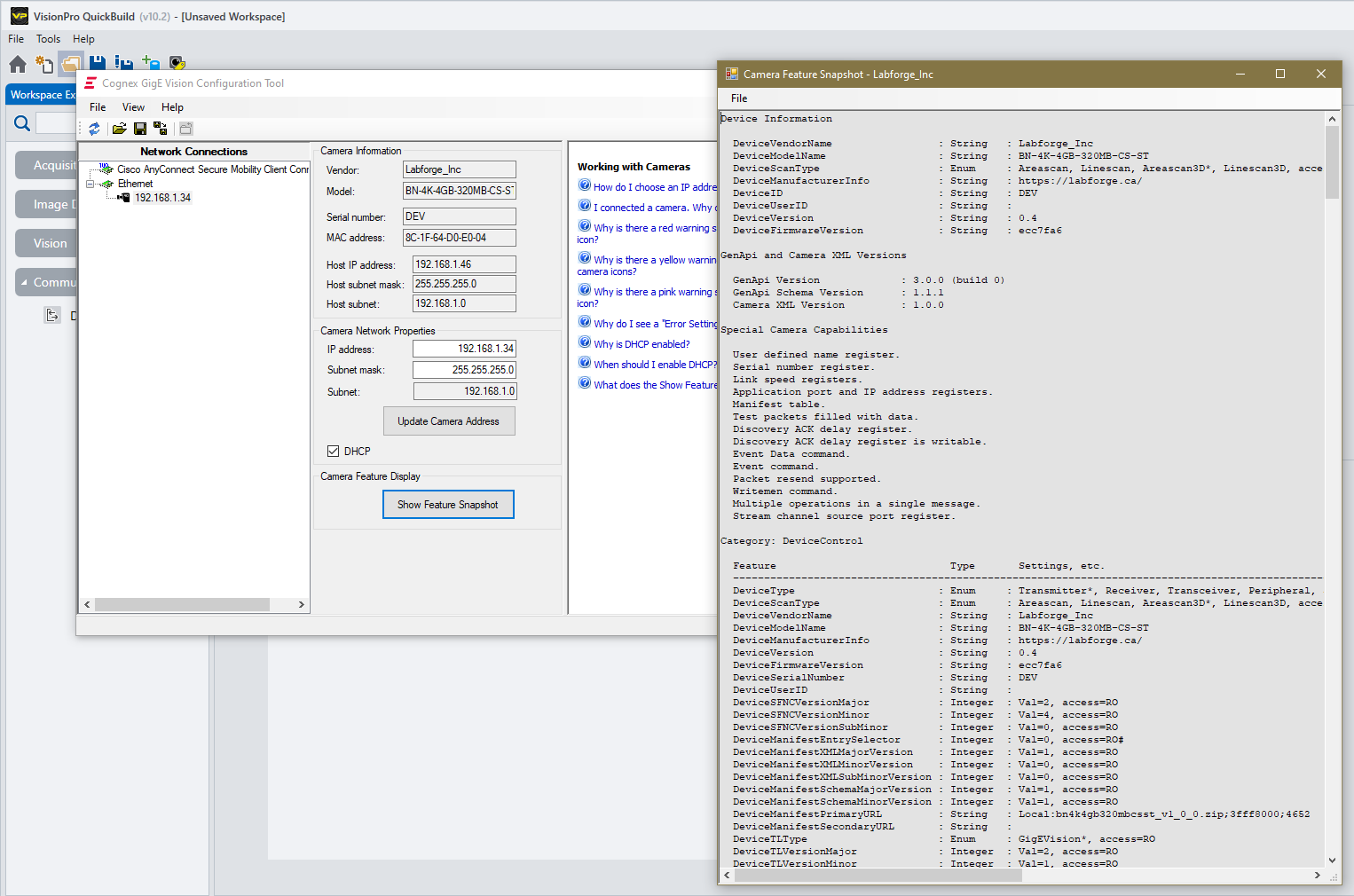
Cognex VisionPro QuickBuild 10.2 GigE Vision Configuration Tool showing properties of a connected Bottlenose camera.
Bottlenose with Matrox Imaging®
Matrox Design Assistant® X1 is an integrated development environment (IDE) for Microsoft® Windows® where vision applications are created by constructing an intuitive flowchart instead of writing traditional program code. In addition to building a flowchart, the IDE enables users to design a graphical web-based operator interface for the application. Matrox Design Assistant X can operate independently of hardware, allowing users to choose any computer with CoaXPress®, GigE Vision®, or USB3 Vision® cameras and get the processing power needed.
As a GigE Vision 2.1 device, Bottlenose can be used with Matrox Design Assistant X. For this, the camera has to be connected onto the same subnet as the computer running the Matrox application. Once a camera tool is added to the project from your Camera Page inside Matrox Design, the connected Bottlenose can directly be accessed as a source camera. The Camera Live button provides a real-time live view of the camera inside the designer.
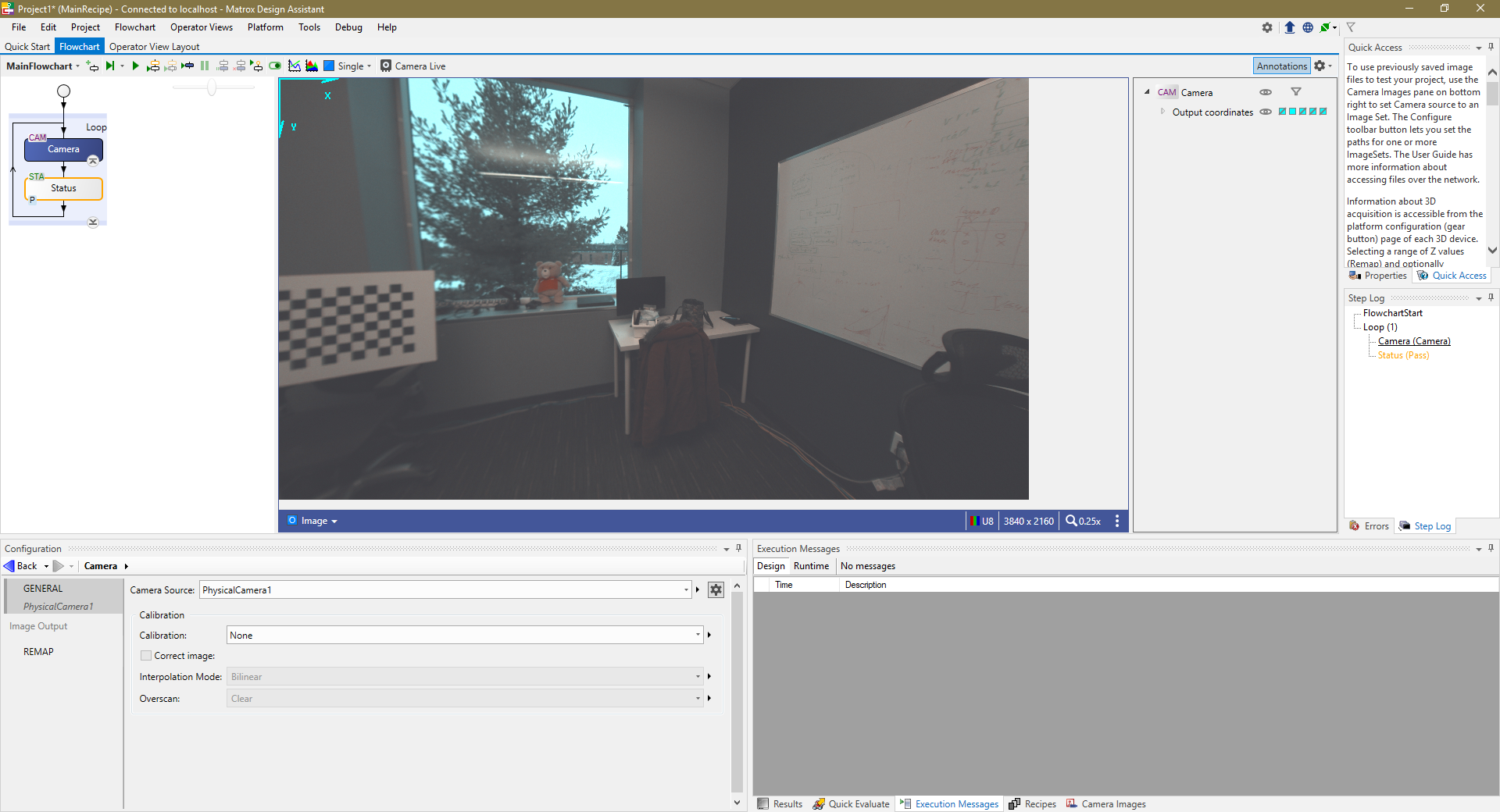
A screenshot of the Matrox Design Assistant X1® showing a view from a connected Bottlenose camera.
Properties of the camera can also be accessed directly from within the Matrox Design Assistant by accessing the configuration page of the given camera.
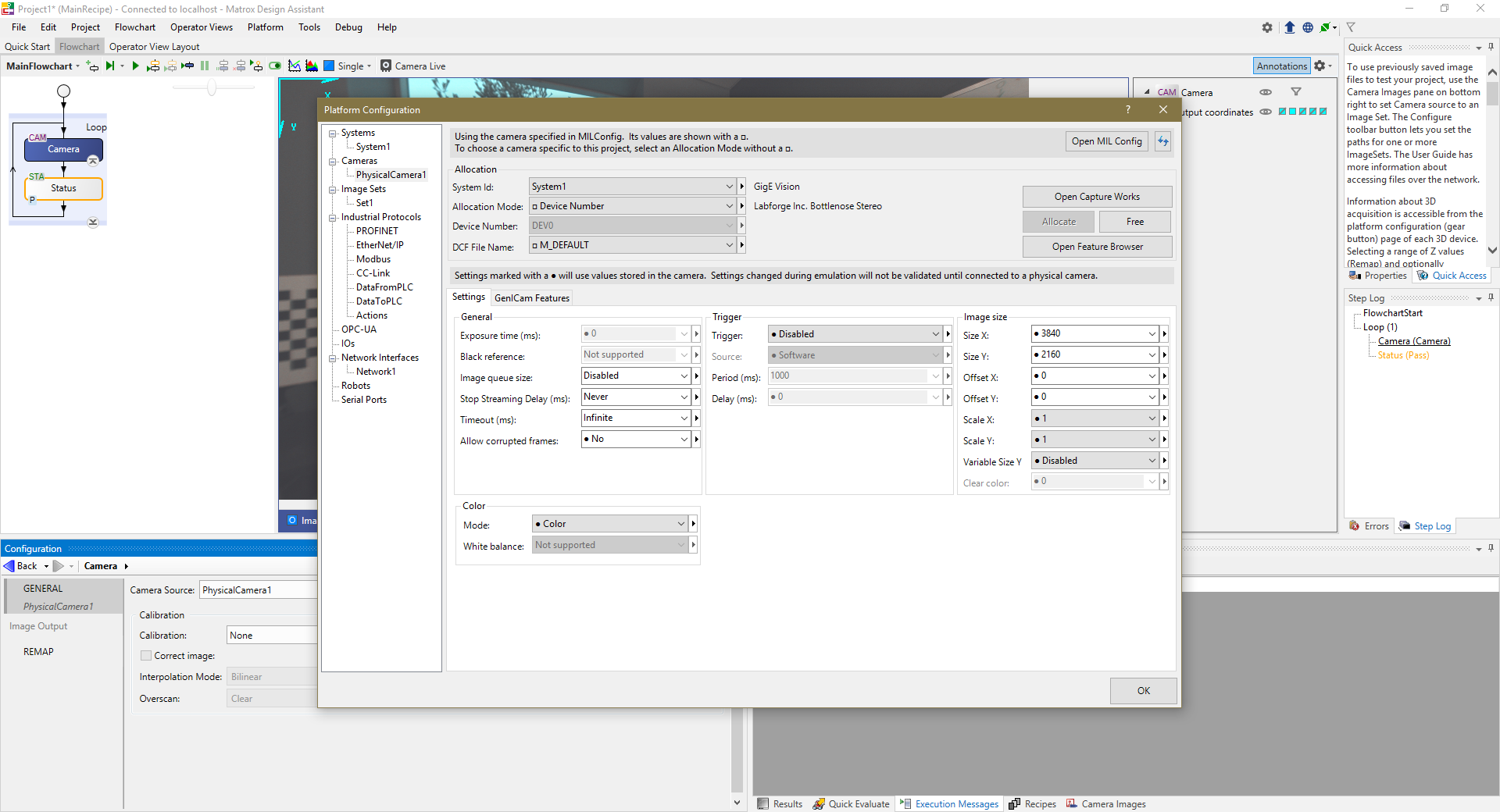
A view of the Matrox Design Assistant X1® Platform Configuration showing properties of a connected Bottlenose camera.
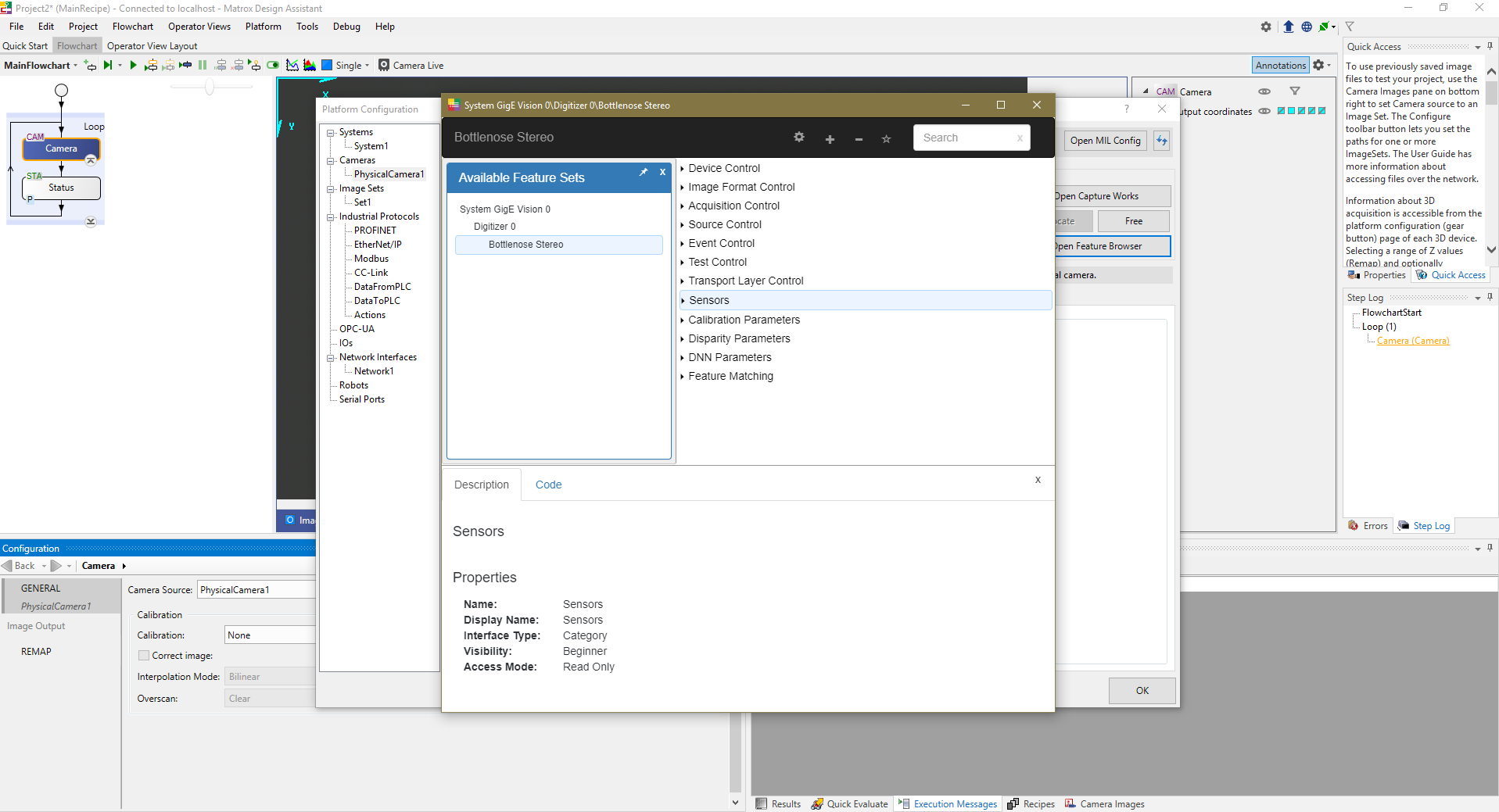
A view of the Matrox Design Assistant X1® Platform Configuration showing tunable high-level features from a connected Bottlenose camera.
Bottlenose with MVTec MERLIC®
MVTec MERLIC is an all-in-one software product for quickly building machine vision applications without any need for programming. MERLIC provides powerful tools to design and build complete machine vision applications with a graphical user interface, integrated PLC communication, and image acquisition based on industry standards. All standard machine vision tools such as calibration, measuring, counting, checking, reading, and position determination, as well as 3D vision with height images are included in MVTec MERLIC.
To use your Bottlenose camera with MERLIC, drag an "Acquire Image from Camera" tool from the Tool Library inside the Tool Flow designer. The Bottlenose camera is assumed to be connected to the same sub-network as the host computer running MERLIC.
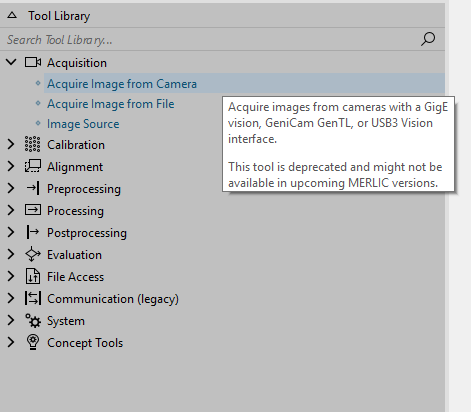
A View of the MERLIC Tool Library
Once the camera tool is loaded, you can select the Bottlenose camera from the list of active devices. This will connect the selected Bottlenose camera and prepare it for interactions.

A View of MERLIC with a Bottlenose Camera connected
By checking the Configure box, MERLIC will load and display all the tunable parameters available on the camera. The user is then free to change any of the values within the defined boundaries.
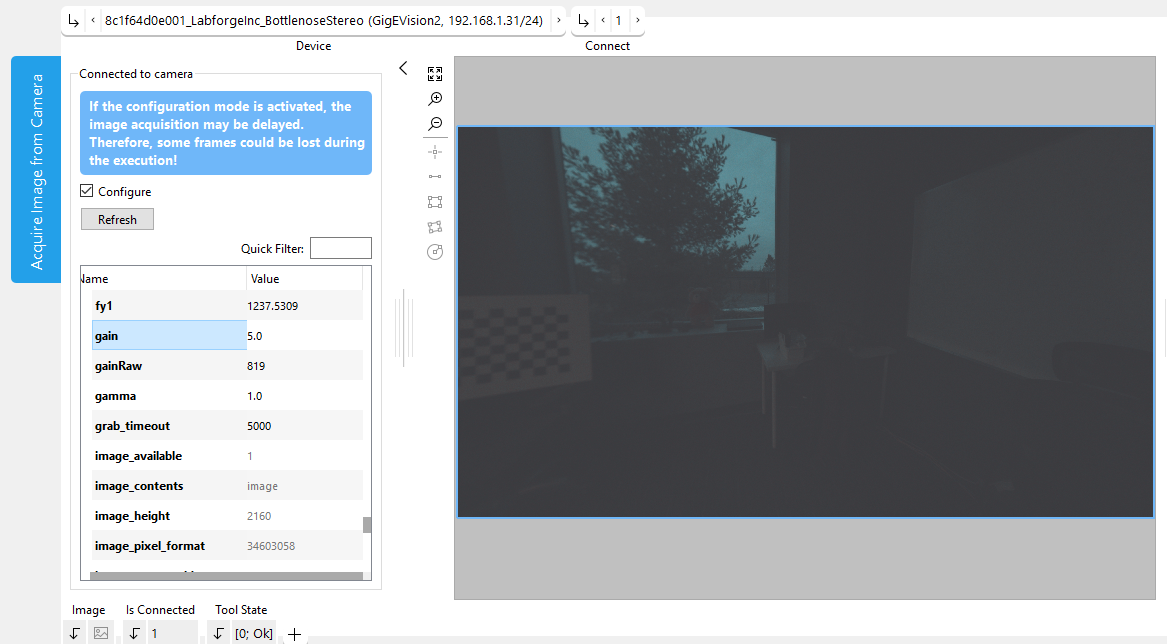
MERLIC with a Bottlenose Camera connected. The list of tunable parameters from the Bottlenose camera is also displayed.
Once connected and tuned to desired parameters, the Bottlenose camera can then be used with existing MERLIC tools.
Bottlenose with National Instruments® Tools
National Instruments (NI) provides a large range of hardware and software tools used by engineers to design, measure, and test applications or new hardware. Below, we look at how to use a Bottlenose from two software packages: LabVIEW and the MAX app.
LabVIEW®
LabVIEW is a graphical programming environment engineers use to develop automated research, validation, and production test systems. The LabVIEW programming environment simplifies hardware integration for engineering applications, thus providing a consistent way to acquire data from various hardware. LabVIEW comes with a large selection of packages and drivers that can be used to speed up application designs. One of these packages required for vision application is the Vision Acquisition Software. This software package contains drivers for acquiring, displaying, and saving images from a wide variety of camera types.
A LabVIEW block diagram programming interface offers multiple functions to choose from when designing an application. To use Bottlenose with LabVIEW, one may need to access the Vision and Motion function. This function block allows to acquire, process, and save images from cameras. Drag and drop the Vision Acquisition block into the block diagram area of the project designer. This will enable the NI Vision Acquisition Express window to load preexisting parameters for the camera. Expand and select the Bottlenose camera under the NI-IMAQdx Devices menu from the Acquisition Sources panel. Click on either Snap, to take a single image, or Grab, to get a stream from the selected Bottlenose camera. Click on Next to configure the camera features.
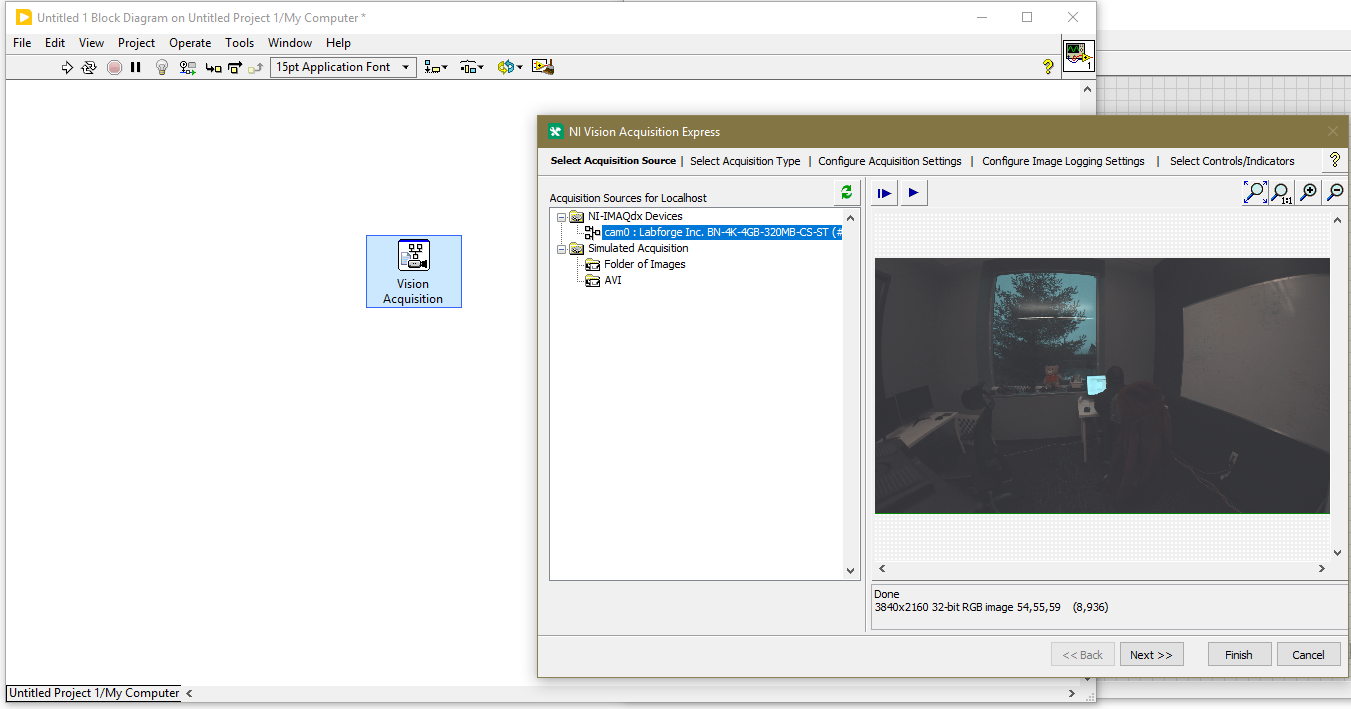
A view from a Bottlenose camera using LabVIEW® Vision Acquisition block.
NI MAX®
The National Instrument (NI) Measurement & Automation Explorer (MAX) is a free software package that comes with a LabVIEW® installation. NI MAX can be used for various tasks such as configuring existing hardware and software, creating and editing channels, tasks, interfaces, scales, and virtual instruments, creating Simulated Devices or simply exploring connected hardware.
To use a Bottlenose camera with NI MAX®, expand the Devices and Interfaces menu from the explorer's left panel. Make sure the computer running NI MAX and Bottlenose are connected to the same network. The active Bottlenose camera should show up under the Network Devices submenu of Devices and Interfaces. Select the camera and choose either Snap, to take a single image, or Grab, to get a stream from Bottlenose. You can also access the Camera Attributes tab to control the various features of the camera.
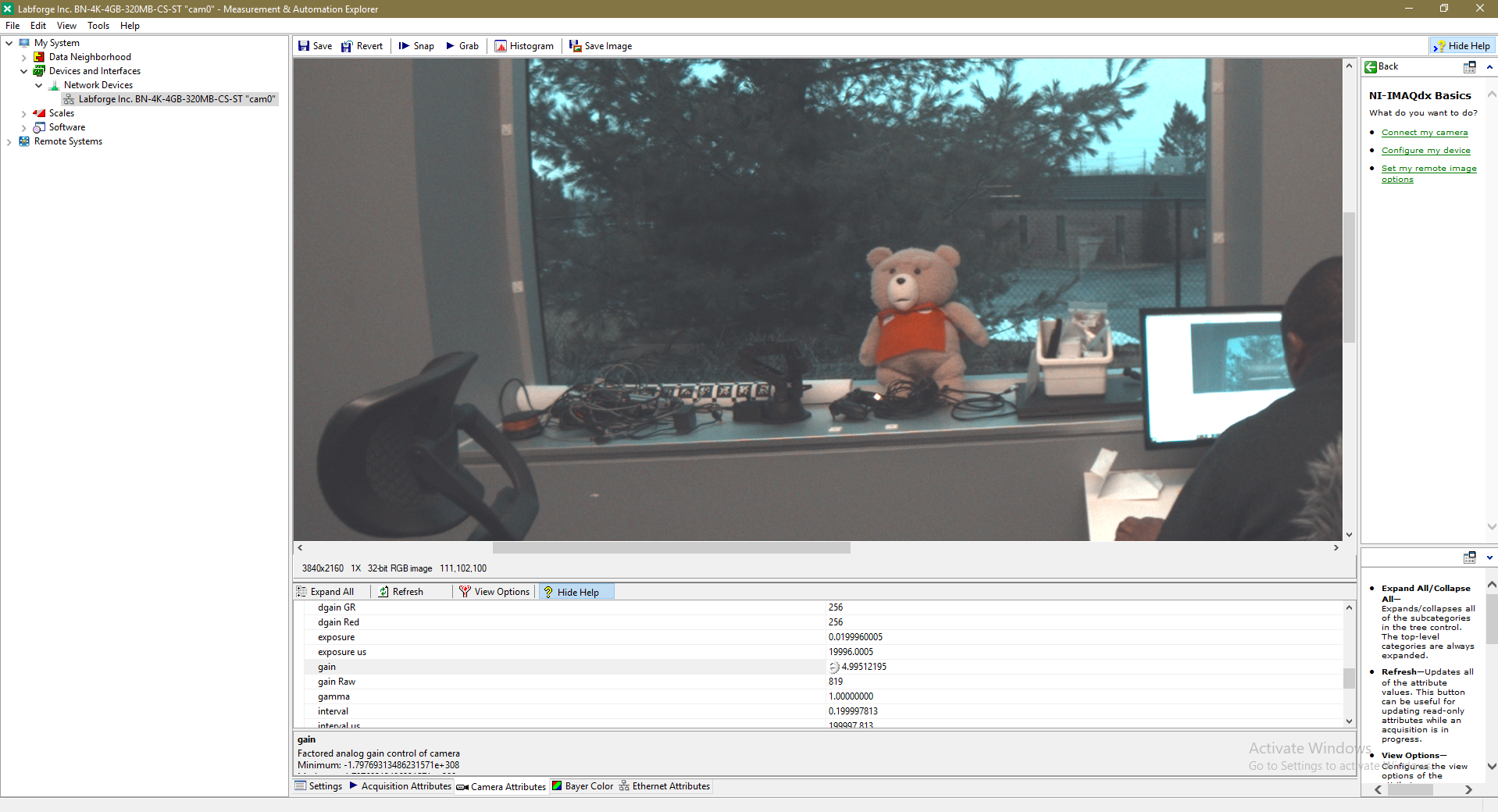
A view from a Bottlenose Camera using the NI MAX® app
Note: If your images show green stripes, this is an indication that you are dropping data packets during frame transmission from the camera. To solve this issue, make sure that you turn on Jumbo frame support on your network interface.
Bottlenose with MATLAB®
MATLAB® is a programming platform designed specifically for engineers and scientists to analyze and design systems and products. The matrix-based MATLAB language provides an easy way to express computational mathematics. Built-in graphics make it easy to visualize and gain insights from data. MATLAB® can be used to analyze data, develop new algorithms, and create models and applications. MATLAB is used for a broad range of applications, in industry and academia, including deep learning and machine learning, signal processing and communications, image and video processing, control systems, test and measurement, computational finance, and computational biology.
To use Bottlenose with MATLAB, the Image Acquisition toolbox should be installed along with the support package for GigE Vision hardware. The list of GigE Vision-enabled cameras can be obtained from the MATLAB command utility using the gigecamlist command as follows:

A Bottlenose camera as listed from MATLAB®
Next, use the gigecam function to construct a GenICam object that will then be used to access and manipulate the camera. This function can with either the IP address, the serial number or the device number of the selected camera. However, if you can always use the function without argument to connect to the first camera found by MATLAB.
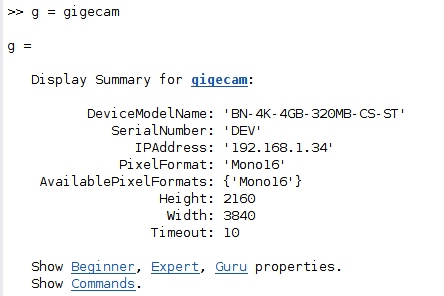
An example execution of the gigecamcommand showing the connected Bottlenose camera
Updated about 2 months ago